Healthcare Scanner
Tarilian Laser Technologies – a case study in due diligence
Januar 2022
When deciding whether to invest in a company, an investor will inevitably have to decide the value of the company.
Taking a simplified view, a company’s valuation can be considered to be made up of tangible assets (e.g. cash, inventory and fixed assets such as plant/machinery) and intangible assets (e.g. Intellectual Property (IP) and the skills and knowledge of the founders and key staff (Human Capital)). While it can be easier to place a monetary value on tangible assets, there is much more uncertainty regarding the monetary value of intangible assets. However, to decide on the value of a company, a monetary value must nonetheless be placed on these assets, in particular the IP portfolio of the company.
Summary of TLT
Tarilian Laser Technologies (TLT) was founded in 2006 with the aim of being able to measure “beat to beat” blood pressure in real time. This level of measurement could be used provide an early identification of any underlying problems, such as hypertension, which might become chronic conditions at a later date. As hypertension affects 1.13 billion people globally, this technology had huge potential and with such a considerable market size, TLT was able to secure rounds of investment over a 13-year period culminating in a valuation of £52m in August 2019. However, by December 2019, the valuation of company assets had plunged to £175k following the realisation that there in fact was no “secret algorithm” capable of measuring “beat to beat” blood pressure values. Leaving aside the personal tragedy, the story of TLT raises two points from an IP perspective which would apply to valuing any high growth company. The first is how TLT’s intangible assets were able to lose their value so quickly. The second is, just because a Patent Office grants a patent does not necessarily make the patent valuable. Given TLT had over 30 granted patents, why weren’t any of these of value?
IP considerations
The first point requires consideration of whether the investors understood the context of TLT’s patents. As valuing patents, or any IP, is contextual, not knowing the context or purpose of TLT’s patents would make it difficult for an investor to assign a meaningful value to these rights. TLT’s IP assets were not inconsiderable, having obtained more than 30 granted patents across Europe, USA, Japan, South Korea, China and Australia. However, this highlights the risks of seeing “patented technology” as a “green light” for investing in a company without knowing the key details of the technology or the purpose of the patents. As the founders and software developers refused to share any details of the algorithm with anyone, it would not have been possible to confirm whether any of the granted patents actually covered the secret algorithm, and therefore confirm the purpose of the patents. As such, any value attributed to TLT’s patents would, at most, only potentially cover the secret algorithm. The value of TLT’s intangible assets would therefore have been heavily weighted towards the value placed on their Human Capital which can be largely attributed to the founders’ clinical experience in angiology and haemodynamics and the fact they were held in high regard in the medical device sector more widely. While it may be difficult to objectively attribute a monetary amount to this factor, it would not be unreasonable for an investor to conclude that TLT had staff with the necessary skills and knowledge to at least theoretically develop the “beat to beat” blood pressure monitoring algorithm. However, once it was apparent the founders were unable to create the secret algorithm, the value of TLT’s Human Capital decreased rapidly.
The second point requires a brief discussion on what TLT could have patented in order to fend off competition. An investor looking into TLT’s patent portfolio would find patents related to different types of vital sign measurement devices and different methods of measuring vital signs, which would suggest the patents were at least relevant to TLT’s technology. However, were these patents related to workarounds which could genuinely compete with TLT’s secret algorithm, or potentially the secret algorithm itself, or even impractical workarounds to keep competitors guessing? While patenting workarounds would create additional barriers for competitors and increase the exclusivity of TLT’s offering, likely improving TLT’s valuation, investors should appreciate that Patent Offices are not examining patent applications in view of the commercial aims of a business, and that provided the application meets the requirements of the relevant laws, a patent can be granted, regardless of whether these patents are relevant to the commercial aims of a business.
That said, it is easy to see how an investor might not see a problem with TLT’s technology based at least in part on the existence of these granted patents, particularly if they do not have a technical background to make an assessment of their own. Afterall, it would be reasonable to assume a company would have at least some patents covering their core technology, and it would seem very unlikely that all of these Patent Offices would miss a problem with the technology described in the applications if there was one? However, this reinforces the need to make sure it is clear what the purpose of each patent is and how each patent adds value to the company. For example, patenting a potential workaround or the commercial technology both add value to the company, but both serve very different purposes. The purpose of each patent must be clear to ensure the IP portfolio as a whole maximises the value of the company. When the purpose of the IP portfolio is not clear, there is even greater uncertainty around the valuation of a company.
IPRs have value even if the rest of the company is dead
The sharp drop in valuation from £52m in August 2019 to £175k in April 2020 highlights how quickly a company’s value can change when a significant proportion of their value is based on intangible assets. However, TLT is by no means alone in this regard, as a recent study showed that on average approximately 90% of a company’s value is in its intangible assets which further demonstrates the need to understand how a company’s IP is actually creating value. As TLT goes into liquidation, Intellectual Property rights make up £165k of £175k of TLT’s remaining assets which shows that even if a business ultimately fails, its IP rights can still provide some value.
This article was prepared by HGF’s Patent Attorney Dr Robert Weinert-Aplin.
































